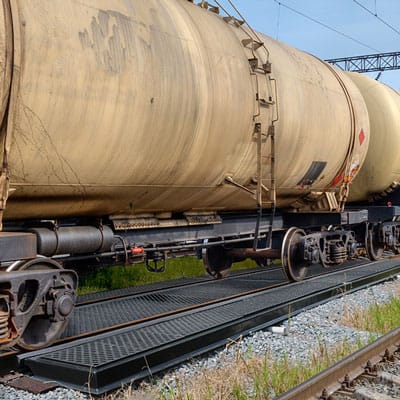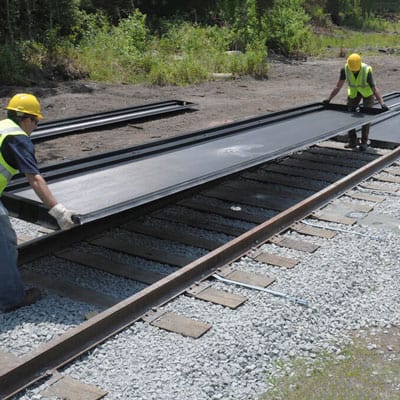Rail transport is one of the most efficient ways to move bulk liquids and hazardous materials across the country. From crude oil and diesel fuel to industrial chemicals, thousands of railcars carry potentially dangerous substances every day. While rail is generally a safe and effective transport method, it isn’t without environmental risks—especially at loading, unloading, and maintenance points.
Accidental leaks or spills can contaminate the soil, pollute nearby waterways, and trigger serious environmental consequences. To prevent these outcomes, railroad facilities are increasingly turning to track pan systems as a frontline defense against environmental contamination.
In this blog, we’ll explore how railroad track pans work, why they’re a must-have for rail operators, and how they stack up against other containment methods. We’ll also walk through some real-world examples of what can go wrong without proper containment in place—and how to avoid those costly outcomes.
What Are Railroad Track Pans?
Railroad track pans are specially designed spill containment systems that fit between and alongside railroad tracks. These pans are constructed from high-strength materials like polyethylene or fiberglass-reinforced plastic, and they’re built to handle harsh weather, chemical exposure, and the daily rigors of rail operations.
Each track pan section is modular, which means facilities can customize the system’s length to suit their specific track layout. With optional center pans, side pans, grating covers, and drain kits, the system is highly adaptable.
When a railcar leaks or spills—whether it’s a few drops or a more significant discharge—the track pan captures and contains the material before it can seep into the ground or reach nearby water sources. The pans can then be drained or cleaned out safely, reducing both environmental impact and cleanup costs.

Why Track Pans Matter for Environmental Safety
1. Environmental Protection at the Source
Hazardous materials spilled from railcars can lead to serious ecological damage. Even small leaks over time can accumulate, causing long-term soil and groundwater contamination. Track pans act as a physical barrier that intercepts these substances before they make contact with the ground.
For rail yards located near wetlands, rivers, or groundwater sources, track pans are especially crucial. They provide peace of mind that even in the event of an accidental spill, the environment will be protected.
2. Regulatory Compliance
Agencies like the EPA enforce stringent rules around spill prevention, especially for facilities storing or handling petroleum products and other hazardous materials. For example, the Spill Prevention, Control, and Countermeasure (SPCC) rule requires certain facilities to have plans and equipment in place to prevent oil spills from reaching navigable waters.
Installing a track pan system is a practical and effective way to meet these compliance requirements. It also shows inspectors and stakeholders that your facility is committed to safe, responsible operations.
3. Reducing Cleanup Costs
Spills are expensive. Between emergency response, cleanup crews, soil remediation, and potential fines, a single incident can rack up tens—or even hundreds—of thousands of dollars in costs. Not to mention the reputational damage or operational downtime.
By capturing leaks immediately, track pans reduce or eliminate the need for large-scale cleanup efforts. They’re a small investment that can pay off massively in the long run.
4. Protecting Your Workforce
Beyond environmental concerns, track pans also contribute to workplace safety. Spilled oil or chemicals on track surfaces pose slip hazards to employees working around railcars. With grating covers and integrated drainage, track pan systems help keep walkways dry, clean, and safe.
5. Supporting Sustainability Goals
If your organization has ESG (Environmental, Social, and Governance) goals or corporate sustainability initiatives, investing in containment systems like track pans can contribute directly to those targets. Customers and investors increasingly expect businesses to operate responsibly—and containment equipment helps demonstrate that commitment.
How Track Pans Compare to Other Containment Solutions
Track pans are not the only spill containment tool available, but they are one of the few systems specifically designed for rail environments. Let’s take a closer look at how they compare to some other common solutions:
Spill containment berms are often used as a temporary barrier around vehicles or equipment, especially in remote areas or short-term projects. While berms are versatile and portable, they’re not ideal for permanent rail installations. They can be cumbersome to deploy and often need to be moved when not in use.
Absorbent pads, socks, and booms are valuable tools for cleaning up minor spills and drips. However, they are reactive rather than proactive. They don’t prevent contamination—they just respond to it after it occurs. They also require regular monitoring and replacement, which can become labor-intensive over time.
Secondary containment pallets are commonly used in warehouses for drums and totes. They’re effective for static storage but not applicable in a rail setting. You can’t exactly roll a tank car onto a spill pallet.
Compared to these solutions, track pans offer continuous, passive protection in high-risk areas like fueling stations, loading bays, and maintenance tracks. They’re always in place, always working, and always ready to catch whatever comes their way.

Track Pan System Components: What You’ll Need
To build a complete, effective track pan system, consider including the following components:
- Center Pans: These fit between the rails and form the core of the system. They’re designed to withstand direct drips from tank car outlets.
- Side Pans: Placed on either side of the tracks, these capture splashes or leaks that might extend beyond the center.
- Grating Covers: Heavy-duty grates allow workers to safely walk over the pans while protecting the system from debris.
- Drain Kits: Drainage outlets can be added to connect the pans to oil/water separators or holding tanks for safe disposal.
- End Seals: These help enclose the system and prevent runoff from escaping at either end.
AbsorbentsOnline.com offers a complete line of track pan components, including all of the above, along with accessories to customize your installation.
Learning from the Past: Real-World Incidents
The environmental cost of inadequate spill containment is best illustrated by looking at past incidents:
In 1970, a Lehigh Valley Railroad train carrying toxic chemicals derailed in Le Roy, New York. The resulting spill of trichloroethylene and cyanide-contaminated the local environment so severely that the site was later designated a federal Superfund cleanup area.
In 1992, a train derailment in Superior, Wisconsin released thousands of gallons of aromatic hydrocarbons into the Nemadji River. The chemical spill killed fish, polluted drinking water, and forced over 80,000 people to evacuate.
Both of these tragedies underscore the importance of preventative infrastructure. While accidents can’t always be avoided, their impacts can be significantly reduced with the right containment tools in place—like track pans.
Best Practices for Track Pan Maintenance
Installing a track pan system is just the first step. To ensure long-term performance:
- Inspect regularly: Look for signs of wear, chemical damage, or debris buildup.
- Clean out sumps: Remove collected fluids promptly to maintain capacity.
- Use absorbents when necessary: For small drips, absorbent pads placed inside pans can simplify cleanup.
- Train your team: Make sure all staff know how to work around and maintain the system properly.
With routine maintenance and smart usage, track pans can serve your facility for many years to come.
Final Thoughts
Railroad track pans are more than just a safety feature—they’re a proactive investment in environmental responsibility, operational safety, and regulatory compliance. Whether you’re managing a fueling station, a chemical loading facility, or a maintenance yard, these systems help keep your operations clean, legal, and efficient.
At a time when environmental standards are rising and public scrutiny is high, businesses can’t afford to be reactive. Installing a track pan system sends a clear message: you’re not just moving materials—you’re doing it safely, responsibly, and sustainably.Ready to protect your site from spills?
Visit AbsorbentsOnline.com to explore track pan systems, request a quote, or talk to a containment expert today.